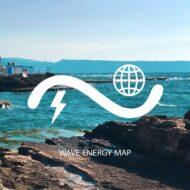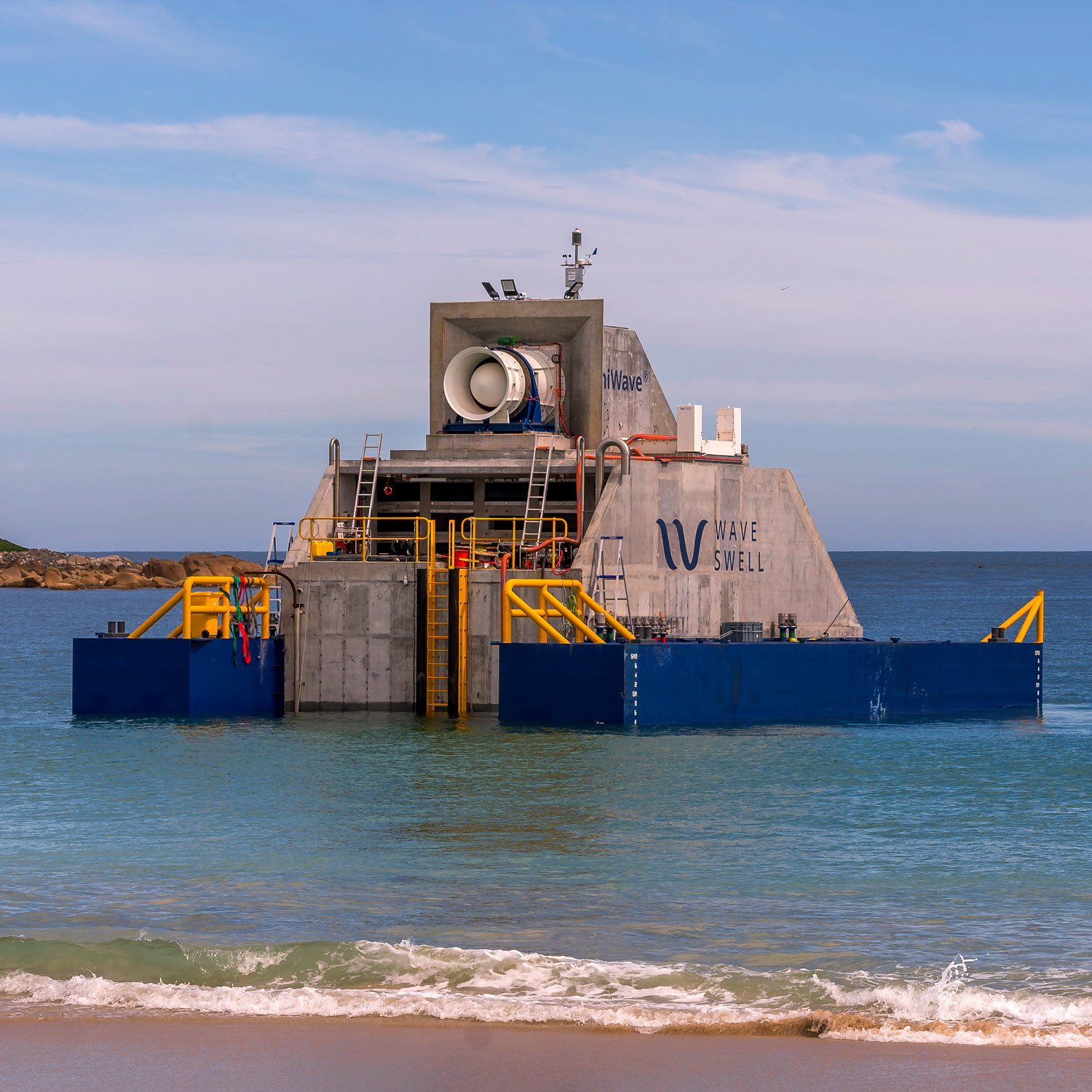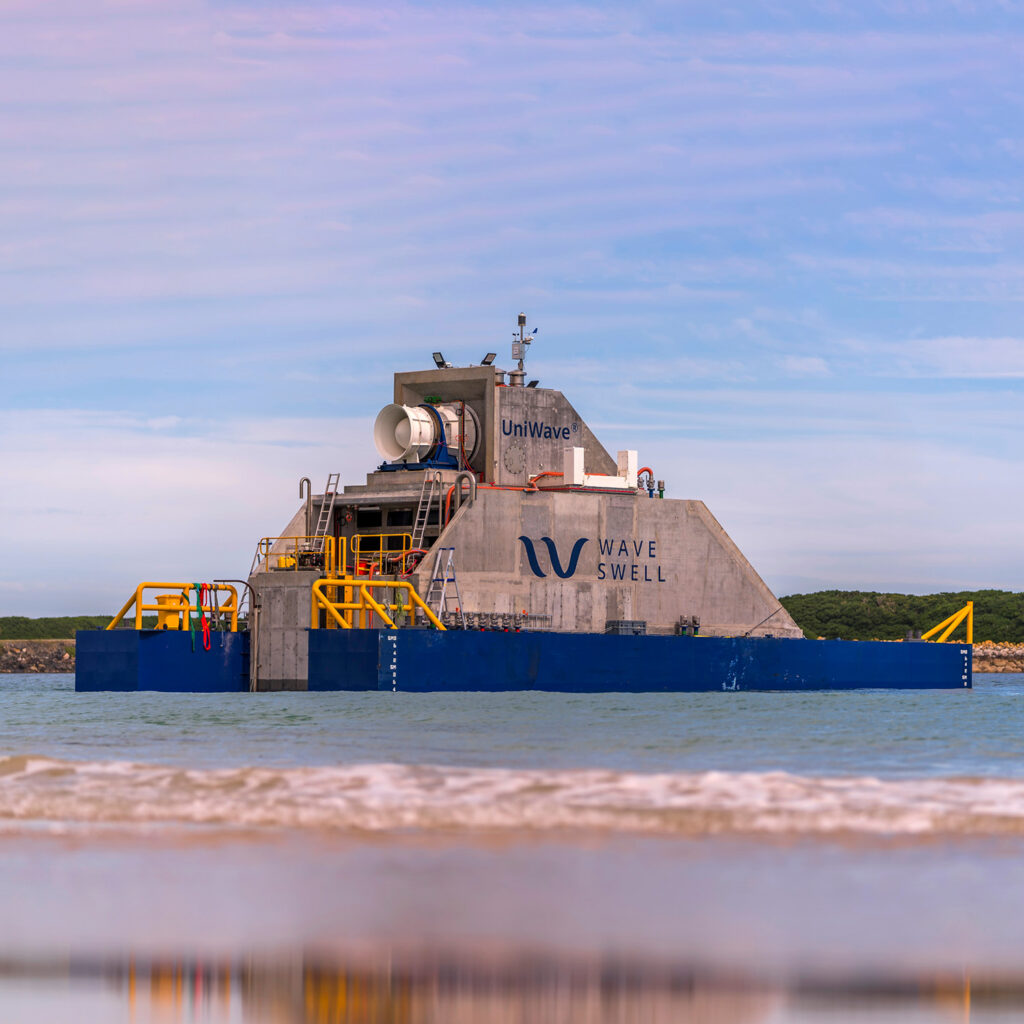
Wave Swell is a developer of world leading proprietary technology which works to convert the energy in ocean waves into clean and emissions free electricity
–
Uniwave®
The Wave Swell Energy (WSE) technology is based on the well-established concept of the oscillating water column (OWC).
–
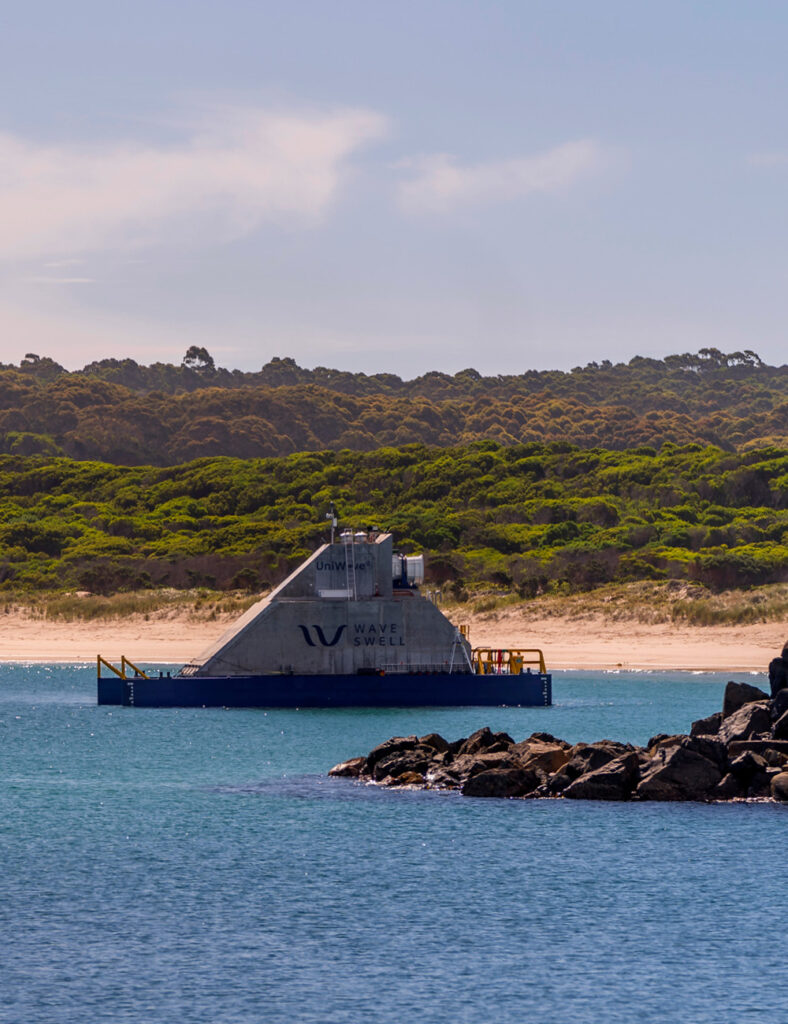
–
The OWC is an artificial blowhole consisting of a chamber that is open underneath the waterline. As waves pass the OWC, the water rises and falls inside, forcing the air to pass by a turbine at the top of the chamber. This turbine generates electricity.
Previous OWC technologies have all been bidirectional. The WSE technology, however, operates unidirectionally. This results in the WSE turbine being simpler, more robust and reliable, and exhibiting a higher energy conversion efficiency. The only moving parts in the technology are the turbine and bespoke valves, all of which are well above the water line. There are no moving parts in or below the water.
–
A world first project
WSE has deployed its 200kW wave energy project on King Island, Tasmania, adjacent to the harbour at the township of Grassy.
–
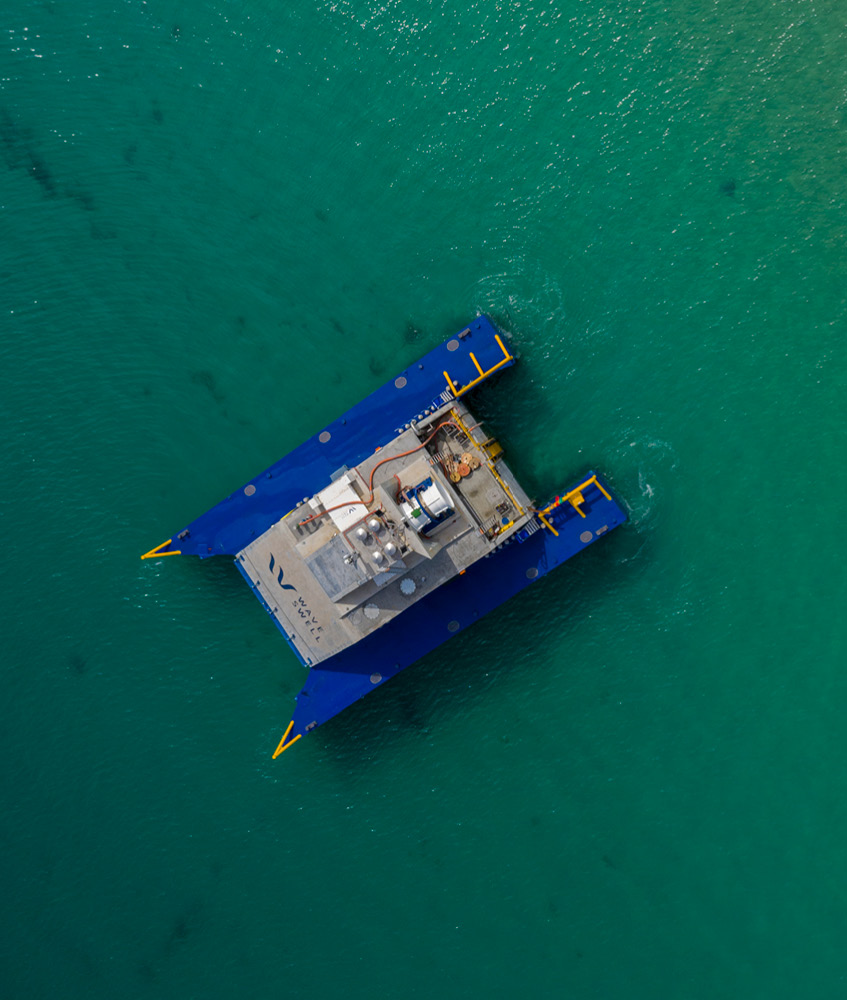
–
The unit was installed at Grassy, King Island, on January 10, 2021. It has since been commissioned, exporting its first power into the King Island grid on June 18, 2021. These are significant events for WSE’s shareholders and stakeholders.
WSE has worked with Hydro Tasmania, the island’s energy and network provider, to connect the unit to the local grid, and is now delivering energy from the project into the existing network. Hydro Tasmania will separately monitor the energy produced by the unit to ensure it meets the requirements of the King Island grid.
The wave energy produced will complement Hydro Tasmania’s existing hybrid grid, further diversifying the renewable sources and reducing diesel consumption on King Island.
The UniWave200 is now contributing to the mix of energy resources used to power the homes and industries of King Island.
–
–
–
What is the King Island Project Expected to Achieve?
The primary purpose of Wave Swell Energy’s (WSE) UniWave200 King Island project is to validate the models entailed in the various stages of the technology’s power conversion process.
–
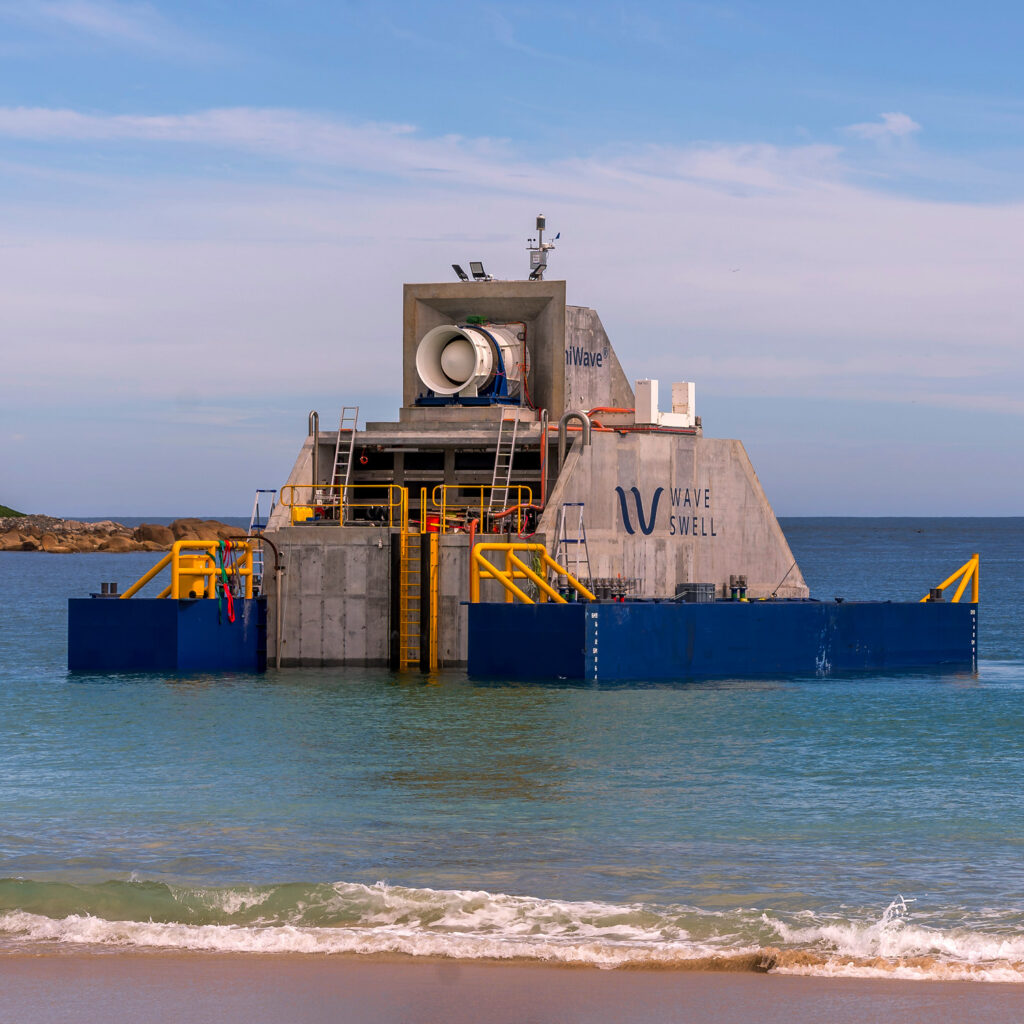
–
This will be achieved in a comprehensive “wave to wire” fashion via the following modules:
- wave to pneumatic power – by validating the Australian Maritime College (AMC) physical scale model testing results in a full-scale ocean environment
- pneumatic to mechanical power – by validating the turbine efficiency model via a full-scale WSE turbine operating in a UniWave200 device in the real ocean
- mechanical to grid – by validating the electrical model via a full-scale electrical system installed in a UniWave device operating in the real ocean
These results will provide WSE with a baseline and the tools and inputs from which to develop the technology further as part of Project Bluefire, the company’s planned technology enhancement program.
The AMC model tests, conducted at the institution’s test tank facilities in Launceston, provide a detailed matrix of pneumatic power1 production across a range of different combinations of model scale wave height and period2. The King Island unit is expected to encounter this same range of wave conditions at full scale at the Grassy site.
A direct comparison of the King Island unit’s pneumatic power with the corresponding results of the AMC model tests will allow the confirmation of the UniWave200’s pneumatic power performance matrix3.
The King Island project is also designed to confirm the performance and conversion efficiency of the WSE turbine4. This bespoke turbine has been designed by a leading expert in the field of turbine design, based in the US.
Additionally, the King Island project will provide data that enables a refinement of the WSE electrical control system. The purpose of this system is to efficiently convert the mechanical energy of the turbine shaft into electricity, minimising energy wastage, and maximising output. This electrical process incorporates a short-term storage facility, utilising state-of-the-art ultra-capacitors, to provide a smoother delivery of electrical energy to the grid.
When the pneumatic power, turbine conversion efficiency, and electrical conversion efficiency matrices are combined with the frequency of occurrence matrix5 for a given site, an accurate estimate of the unit’s power production can then be calculated for that site. In this way, the results from the King Island project will make it possible to accurately predict the total conversion efficiency6 and power output of the WSE technology at any site in the world for which comprehensive wave data7 is available.
The validation and results from these three stages of the process, whereby energy from the waves is converted into electricity, will be the cornerstone of the inputs into Project Bluefire. The outcome of Project Bluefire is expected to be a more efficient and lower cost technology that is more widely applicable in terms of depth and geography.
Finally, the King Island project will be a tangible demonstration of the ability of the WSE unidirectional OWC technology8,9 to produce useable electrical energy capable of being incorporated into an island grid. It will also provide invaluable information and experience related to the unit’s day-to-day and long-term operation and maintenance.
King Island was chosen as a project site for two primary reasons – the wave climate and Hydro Tasmania. The wave climate in the region is amongst the best in the world. And, Hydro Tasmania, being a world leader in the integration of renewables into island grids, provides the project with a virtually unparalleled level of relevant expertise. This will prove significant in demonstrating the technology’s value to remote island grids.
Grassy, on the east coast of King Island, was chosen as the specific project site for additional reasons. As the main commercial harbour for the island, the general site already has the necessary electrical and other infrastructure required by the WSE project. And, being on the east coast of the island, the wave conditions that will be encountered are expected to cover the full range, from small to large, needed to validate the AMC model tests. Given this project involves a demonstration unit, there is as much to be learned from the operation and maintenance of the unit as there is from the production of power. The Grassy location provides the ideal conditions required for regular and easy access for operating the unit, as well as delivering the range of wave conditions necessary to fully test the device.
Importantly, the King Island project is not aimed at maximising the power production of the unit. Doing so would require a more energetic wave location, such as the west coast of the King Island. Future projects, incorporating the improvements from Project Bluefire, will be located in more energetic wave regimes to maximise energy production.
Glossary of Terms
- Pneumatic Power: Power measured at the pneumatic stage of the conversion chain given as the product of the volume flow rate (m^3/s) with the differential pressure (Pa) between the OWC chamber and atmosphere.
- Wave Height and Period: Wave height is the vertical distance between the wave crest and trough. Wave period is the time between two wave crests.
- Pneumatic Power Performance Matrix: A two-dimensional graphical representation of the pneumatic power (pressurised air flow) corresponding to the sea state (a combination of a specific wave height and period).The matrix normally consists of height on the vertical axis and period on the horizontal axis.
- Turbine Conversion Efficiency: The proportion of pneumatic power the rotating turbine converts to mechanical power.
- Frequency of Occurrence Matrix: For a given location, the frequency (how often) each sea state occurs is known as the Frequency of Occurrence Matrix.
- Total Conversion Efficiency: The proportion of wave power that is converted into electrical power across all stages of the energy conversion process.
- Wave Data: The sea state collected at a given location that allows for the Frequency of Occurrence Matrix to be populated (filled in).
- OWC (Oscillating Water Column): An oscillating water column consists of a large chamber that sits partially below the water and partially above, with a ‘mouth’ or entry duct open below the water line, and a small aperture open above. The chamber acts like an artificial blowhole, with energy from the waves entering and leaving the mouth, and energy in the air flow entering and leaving via the aperture, in which is housed a turbine.
- Unidirectional OWC: A variant of OWC technology that is unique to Wave Swell Energy and protected by an international patent. The technology enables simple rectification of air flow so that a more efficient and robust unidirectional air turbine can be used for pneumatic to mechanical energy conversion. Temporary energy storage in the water column is the key to why this concept works and explains why the energy is not being lost by venting the air chamber.
–
Wave Swell website
